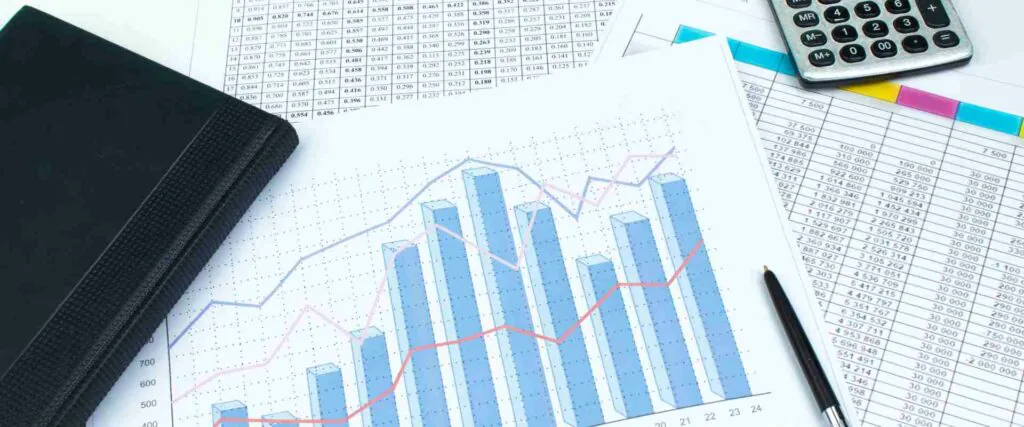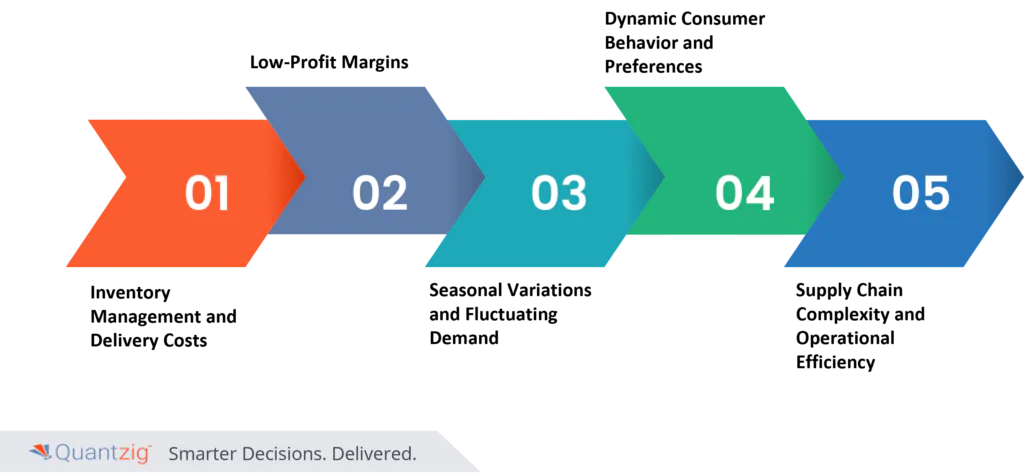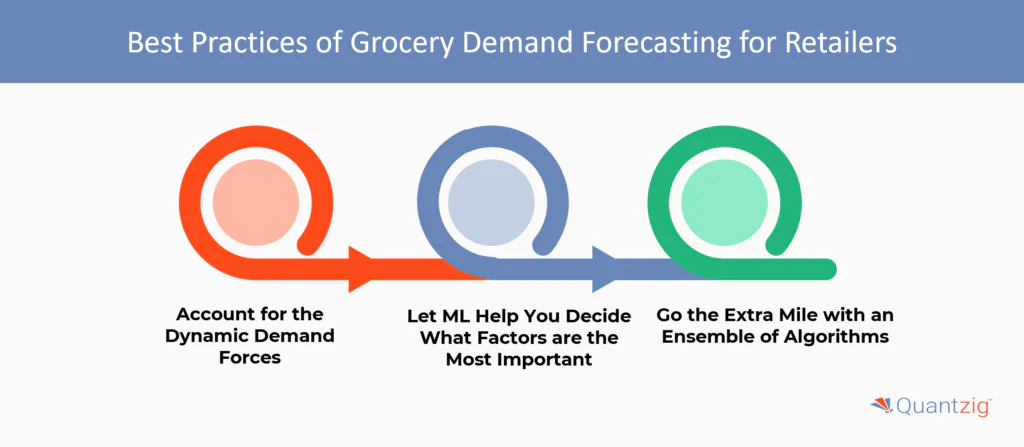Written By: Sudeshna Ghosh
Table of Contents
Introduction to Grocery Demand Forecasting
In the rapidly evolving landscape of e-commerce, online grocery stores are leveraging demand forecasting analytics to optimize operations, enhance customer satisfaction, and drive profit margins. By harnessing the power of data analytic services, these platforms can anticipate consumer preferences, inventory levels optimization, and streamline supply chain operations, thereby gaining a competitive edge in a saturated market. However, while grocery demand forecasting offers myriad benefits, online stores face unique challenges that necessitate innovative solutions and strategic approaches to ensure sustainable growth and profitability.
Book a demo to experience the meaningful insights we derive from data through our analytical tools and platform capabilities. Schedule a demo today!
Request a Free DemoQuantzig’s Expertise in Grocery Demand Forecasting Solution for a Leading US-based Retail Brand
| Category | Details |
|---|---|
| Client Details | An online grocery major offering a wide range of grocery products. |
| Challenges Faced by The Client | – The client faced the risk of food wastage resulting in markdowns and margin loss due to incorrect grocery demand forecasting. – Needed to devise effective forecasting strategies to manage out-of-stock items, increase sales, and lower markdowns. – Aimed to leverage Quantzig’s expertise in retail analytics for accurate demand forecasting. |
| Solutions Offered by Quantzig | – Developed a hybrid forecasting model to precisely predict demand, reducing markdowns and driving profit margins. – Increased transparency of sales and marketing spend. – Enhanced conversion rates and customer knowledge. – Improved collaboration with sales teams. – Envisioned closed-loop marketing outcomes. |
| Impact Delivered | – Significant reduction in markdowns, boosting profit margins. – Increased transparency in sales and marketing expenditure. – Higher conversion rates and better customer insights. – More effective collaboration with sales teams. – Achieved clear understanding of closed-loop marketing impacts. |
About the Client
An online grocery major offering a wide range of grocery products.
Challenge Faced by the Client
The online grocery client was looking at devising effective strategies to deal with the risk of food wastage, which had resulted in markdowns and margin loss due to incorrect grocery demand forecasting. To drive profit margins through accurate techniques of forecasting, the client – a leading grocery store – approached Quantzig. The client wanted to leverage Quantzig’s vast experience in retail analytics to their benefit and devise effective forecasting strategies to get notification about out-of-stock items, increase sales and lower markdowns.
Impact Delivered from Quantzig’s Grocery Demand Forecasting Solution
Quantzig’s solution enabled the client to develop a hybrid forecasting model to precisely predict demand which helped them drive profit margins by reducing markdowns. The model also enabled the client to increase the transparency of sales and marketing spend
Also, the solutions offered by the analytics experts at Quantzig assisted the client to increase conversion rates, enhance customer knowledge, collaborate more effectively with sales teams, and envision the closed-loop marketing outcome.
Retail Store Demand Forecasting Solution Insights
Strategies that we recommended based on our analysis to help our clients become more customer-centric through tailored services.
As the omnichannel retail strategy takes off, the only big issue for retailers is to try and get a handle on targeted online demand and omnichannel expectation. Also, since retailers come across situations where the demand may be generated from a different location than the fulfillment location. They need to figure this out by implementing various techniques to supplement in-store forecasts with forecasts.
Moreover, in today’s retail scenario, advanced forecasting methods may seem to be a capability that most stores need, but a very few extend this capability to the extent where harnessing consumer demand turns out to be a competitive advantage in managing the business profitably. However, for any techniques of demand forecasting to succeed, retailers need to focus more on merchandising analytics and key focus area, which is the core aspect of demand forecasting methods.
Get started with your complimentary trial today and delve into our platform without any obligations. Explore our wide range of customized, consumption driven analytical solutions services built across the analytical maturity levels.
Start your free trialOverview of the Retail Industry
The retail industry has seen a rapid overhaul with grocery demand forecasting analytics, let’s see how: the increasingly digital lifestyle of consumers today has transformed the way people shop – clothing to shoes to almost everything. The grocery segment is not far behind and is slowly adopting strategies to be part of the ongoing digital revolution.
Owing to the rapid transformations in the retail industry, both big and small retail chains have started venturing into the new ‘online grocery’ segment. Retail shopping is catching up with consumers rapidly. Recent retail industry reports also state that about one-fourth of online shoppers shop groceries on the internet while the remaining 55% are most likely to opt for it in the near future.
Also, it has been estimated that grocers across the world are growing at a 3x rate year-over-year in order to cater to the growing customer base. Though such stats look promising for new market entrants, retail stores face several challenges owing to the perishable nature of food products. This very fact makes running a store more challenging than any other segment within the retail industry such as – electronics, home décor, apparel, and other such goods.
Although leading online retail stores have taken several initiatives to drive customer centricity, they still have a long way to go. This makes it essential for them to understand the need to augment the use of the right technology and analytic-based solutions, such as those offered by the experts at Quantzig.
Why are Grocery Demand Forecasting Solutions Important for Retailers?

Nowadays, retailers face unprecedented top and bottom-line pressure for the irrevocably changed environment. Moreover, Quantzig’s experts suggest that consumers are challenging brand loyalty by changing their brands frequently.
The enduring nature of those challenges are an indication that they need to catch up with evolving target audience preferences and strengthen the supply chain to make sure that shelves are properly stocked –online and in stores. It has become increasingly crucial to get forecasting right down to the Gaps in On-Shelf Availability (OSA), both online and in-store, can be catastrophic and result in lost volume, lost baskets, and lost faith among shoppers.
It is also a very strategic piece of the puzzle in a retail organization. It has a direct effect on the financial health of a retail organization –profit margin, working capital, cash flow, and operational expenses are some of the key business metrics that it affects. Moreover, it is one of the key features of growth and market expansion.
What are the Potential Challenges while Implementing Grocery Demand Forecasting Solution?
Grocery demand forecasting analytics, although a transformative tool for online stores, presents several challenges that require meticulous planning, advanced technologies, and domain expertise to overcome.

1. Inventory Management and Delivery Costs:
Retail stores deal with different types of food products and it includes those that have a limited shelf-life. Therefore, to effectively handle perishable items specialized delivery containers, warehouses, and delivery vans must be deployed to ensure the perishable food products are delivered fresh. Players in the retail segment face major challenges in deploying such vehicles as it requires a lot of initial investment.
2. Low-Profit Margins:
Though a huge chunk of the global population prefers shopping online, they tend to be reluctant when asked to pay for faster delivery and quality assurance. Overcoming such challenges by catering to customer needs turns out to be a major challenge for grocers.
3. Seasonal Variations and Fluctuating Demands:
Online retail stores often grapple with seasonal variations and fluctuating demand patterns influenced by holidays, festivals, and regional events. Predicting consumer preferences and adjusting inventory levels accordingly pose significant challenges, as misalignment can lead to stockouts, overstocking, increased holding costs, and missed revenue opportunities. To mitigate these challenges, retail stores must leverage historical data, market trends, and predictive models to anticipate seasonal variations, optimize inventory levels, and tailor marketing strategies to meet evolving consumer needs effectively.
4. Dynamic Consumer Behavior and Preferences:
The online retail segment witness’s dynamic consumer behavior and evolving preferences influenced by factors such as lifestyle changes, dietary trends, health considerations, and technological advancements. Identifying emerging trends, understanding consumer motivations, and adapting to shifting preferences require continuous monitoring, data analysis, and innovation. By leveraging customer intelligence, sentiment analysis, and machine learning algorithms, retail stores can gain insights into consumer behavior, personalize offerings, and enhance customer engagement, thereby fostering loyalty and driving revenue growth.
5. Supply Chain Complexity and Operational Efficiency:
This solution in the retail segment necessitates addressing supply chain complexity, optimizing logistics, and enhancing operational efficiency to meet customer expectations and maintain profit margins. Managing perishable items, ensuring timely delivery, minimizing wastage, and optimizing transportation routes present formidable challenges that require integrated planning, real-time monitoring, and agile strategies. By implementing advanced supply chain management systems, leveraging predictive models, and fostering collaboration with suppliers and logistics partners, retail stores can enhance supply chain visibility, improve inventory turnover rates, and streamline operations, thereby driving profitability and customer satisfaction.
How Do AI & ML Transform Grocery Retail Demand Forecasting?
The inability of traditional static forecasting to adjust to consumer preferences and dynamic market changes affects the overall forecasting effectiveness. To achieve accurate forecasting, category managers must also consider the appropriate models and demand indicators for each combination of channel, store, and category. This is not possible with a manually managed forecast model. This is where ML and AI-powered Demand Forecasting come into the picture.
AI and ML-powered forecasting frameworks perform impressively because of their innate capacity to process large amounts of unstructured data, spot hidden trends and patterns, and produce predictions for numerous custom disruption constraints. They enable retailers to achieve accurate forecasting for 90% of the SKUs, outperforming manual and static modeling in the process.
1. Handling Data Issues
Despite having an abundance of data, retailers frequently struggle with noisy and sparse data sets. They rely on outside teams to clean the data, which is a time-consuming process, or they fail to recognize these issues, endangering their forecasting.
When combined with machine learning techniques, AI can handle noisy data with ease and detect anomalies and erroneous data. Techniques like attribute-based forecasting can fill in the gaps and produce precise demand curves for new products for sparse data sets. You don’t need the assistance of any outside teams to accomplish any of this.
2. Enriching Data with Real Predictors of Demand
Let’s take the weather as an example of a sales predictor. Temperature and sales have a strong causal relationship for categories like desserts and cold beverages. Therefore, the classical forecasting framework will significantly fail if the average temperature during the forecasting period is higher than it was the previous year. Demand is influenced by a variety of internal and external factors, including pricing and inventory, as well as macroeconomic factors, holidays, and the weather.
Due to data complexity, incorporating this vast array of information into your forecast is extremely difficult. However, with a few clicks, Machine Learning algorithms can incorporate a variety of predictors and relationships that affect demand every day into your retail forecasts.
3. Selecting Channel, Category, Store-specific Predictors
Selecting the appropriate predictors for each category or product presents a challenge for demand planners frequently. This choice is frequently based on historical knowledge of the category’s behavior, or worse, using a one-size-fits-all methodology.
For instance, demand for chilled beverages is strongly correlated with weather, but demand for meat products increases sharply on weekends and holidays. Given the significant differences in the categories’ predictors, applying the same strategy to both could be disastrous. AI/ML-powered Forecasting can predict the important indicators of demand for a combination of channels, stores, and categories. This significantly raises the overall data forecasting accuracy.
AI and ML are revolutionizing grocery retail demand forecasting by enhancing inventory management and supply chain management. By analyzing historical sales data with high data quality, these technologies provide real-time insights and predictive analytics on consumer behavior. Predictive modeling helps retailers optimize stock levels, leading to improved customer satisfaction. In the global grocery retail market, the integration of AI and ML ensures precise demand predictions, streamlining operations and reducing waste.
Best Practices of Grocery Demand Forecasting for Retailers

1. Account for the Dynamic Demand Forces
With convenience and price sensitivity changing the way consumers shop, the demands for retail products have become much more volatile and difficult to predict with simple models. It has become imperative for grocers to enrich their data and avoid rely on traditional data. For accurate forecasting, it’s important to account for external factors such as holidays, weather, social media, events, and news and internal factors such as advertising, promotions, visual merchandising.
2. Let ML Help You Decide What Factors are the Most Important
With a huge range of external and internal causal variables affecting every store, sales, channel, and category combination behaves differently. One of the biggest mistakes that grocers make is to force-fit models without proper understanding the nuances that are at play.
In the multivariate framework, it is difficult and cumbersome to determine the importance of each factor manually. ML algorithms, however, can help to sift through data and determine the effect of each factor. This can feed in as an input for the planner to generate accurate and granular monthly, weekly, and daily forecasts.
3. Go the Extra Mile with an Ensemble of Algorithms
While forecasting sales of various products, there is a slim chance that you will find an algorithm that works for all locations, products, and situations. Champion grocers go the extra mile with an ensemble of algorithms that is customized depending on the data. This ensures that grocers should avoid over-fitting of models across their product lines and achieve better overall accuracy.
Experience the advantages firsthand by testing a customized complimentary pilot designed to address your specific requirements. Pilot studies are non-committal in nature.
Request a free pilotConclusion
In conclusion, demand forecasting serves as a cornerstone for driving profit margins and sustainable growth for stores by enabling data-driven decision-making, optimizing inventory management, and enhancing operational efficiency. However, navigating the unique challenges inherent to the segment requires innovative solutions, strategic investments in technology, and a deep understanding of consumer behavior, market dynamics, and supply chain complexities.
By leveraging advanced analytics, embracing technological advancements, and fostering collaboration across the value chain, stores can overcome challenges, capitalize on opportunities, get long-term success, and establish a competitive advantage in a rapidly evolving marketplace. Through continuous innovation, customer-centric strategies, and a proactive approach to addressing industry-specific challenges, online stores can achieve operational excellence, foster customer loyalty, and drive sustainable profitability in an increasingly competitive landscape.



